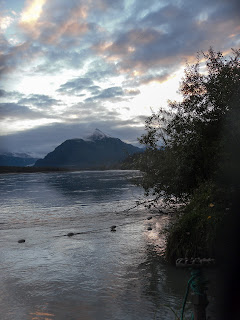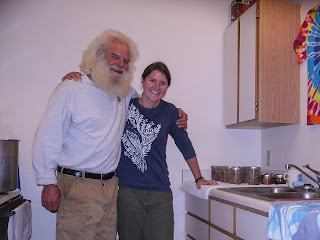With fall settling in and snow on its way, it's time to start preparing for winter. Haines is one of the few towns in Southeast Alaska connected to the interior by the road system. The town is located along the Haines Highway, which travels inland to Haines Junction in the Yukon and links up with the Alcan Highway. Most places in Southeast Alaska are accessible only by ferry or plane. But a road system does little good in winter months when heavy snowfall and ice make crossing mountain passes difficult and dangerous.
Ferries and ships are the most reliable means of transportation during winter months, but these vessels can be hindered by icy waters and bad weather. Groceries and other goods are transported to Haines only once weekly, by barge. If you want to survive in Haines during the winter, you need to make sure you have plenty of firewood and a good supply of food stocked up for the long, dark months ahead.
People in Haines are fortunate to have access to some of the best wild foods available anywhere. Their salmon runs are plentiful. Many subsistence hunters are lucky enough to harvest moose in the fall, or are given part of a moose by friends or relatives (a single moose can yield more than 800 pounds of meat). Wild berries and roots are collected throughout summer and fall, and although the growing season is short and soils are acidic, red potatoes, chard, beets, mixed greens, zucchini, and carrots grow reasonably well in gardens here. It's impractical to rely on the ferry to bring in your groceries every week. Your best bet? Stock up on food when it's available, and can everything you have for winter.
This year, I learned about canning... what else? Salmon!
The canning process is extensive. It all starts with catching the fish. This is a 5 foot long gill net that belongs to our friend Mike, a subsistence fisherman in Haines. Each year Mike fishes along the Chilkat from late spring through early fall, catching and processing Sockeye, Coho, King, and Chum salmon. Salmon swimming upriver to spawn rest in eddies along the banks, and, on their way out of the eddies, become entangled in gill nets like these.
When a fish becomes stuck, the net is removed and the fish is instantly killed. Subsistence fishers must also immediately cut off the dorsal fin of the fish-- this marks it as a subsistence catch so that it cannot be sold to market.
Once the fish is killed, it's time to fillet. Here is Taal at work filleting a fresh-caught salmon:
Salmon fillets can be cooked and eaten immediately, but when salmon are running strong and many fish are caught each day, it's time think about preserving the catch. Fillets can be vacuumed sealed and frozen, or immediately canned. They can also be smoked! Smoking fish is a bit of a luxury, for those who have the time and the energy to build and maintain a smokehouse. Smoked fish has the best flavor of any type of prepared salmon, but smoking can take several days. Smoke levels need to be constantly monitored, and there is always the threat of bears coming by and raiding your entire catch.
The first step in smoking is building a fire. Time to chop some wood!
The Tlingit Indians that live in Klukwan, the native village here, typically use black cottonwood in their smokehouses, while others, including Mike, use alder. The salmon fillets are brined in saltwater and then placed or hung in the smokehouse for anywhere from one to three days, depending on the intensity and temperature of the smoke and the desired outcome. Here's the smokehouse on day two of a three-day smoke.
Smoked salmon can be eaten as-is, but won't last long before going bad. (Salmon jerky can also be made this way, and has a longer shelf life, as it is dried almost completely.) In order to preserve the fish to use for winter months, the smoked fish must be canned.
Canning salmon is just about like canning anything else. Glass jars, in pint or half-pint size, are thoroughly cleaned and sterilized in boiling water. If you're really keen on putting in the effort to make your jars nice, you can remove the skin from the fillets. I took the time to do this, and Mike usually does, too, as he cans fish for a lot of other people. Also, the dogs get to eat the skins. :D
Most folks leave the skin on, because it's a lot less time-consuming. The skin almost falls off of canned salmon, and a lot of people, especially the Tlingits, eat it along with everything else-- it has a high nutritional value. Removing it before canning comes down primarily to aesthetics.
Smoked fillets are cut into "fingers" and arranged nicely in the jars (if you're anal-retentive like me) or stuffed in haphazardly (if you're like... most other people here, I guess). At this point you can add in flavoring if you wish. Some people use olive oil or soy sauce, others get fancy and use fruit juices, brown sugar, or spice mixes. We used olive oil.
In the jar they go! The photo below shows me canning fresh-pack salmon-- fish that hasn't been smoked but is canned immediately after filleting. A bit of salt is added to these jars to help preserve the fish. Smoked salmon has better flavor, and can be used in salads, sandwiches, rice or pasta, or eaten straight from the jar. Fresh-pack fish is used more like raw salmon, in salmon patties or chowder, or like tuna fish in sandwiches and dips.
Once the salmon is in the jars, sterilized lids are added, and the jars go into the pressure cooker. A steady pressure is maintained for anywhere from 30 minutes to two hours. Everyone learns the canning process a little bit differently, and so every person who cans fish here has a slightly different brining/smoking/canning/seasoning/cooking method. Mike cooks his smoked fish for an hour and fresh-pack for an hour and a half.
Monitoring the pressure cooker:
Once the pressure cooker finishes its work, we remove the jars and let them cool for an hour or more. We also listen for the sweet sound of jars sealing, the little "plock" of the seal on the lids securing. If the lids don't seal, the fish must be eaten within a few days. Here Mike and I stand next to our first batch out of the pressure cooker. Everything sealed!
Once the jars cool completely, we wash them off and label the lids with the type of fish (sockeye, coho, etc.), preparation (smoked or fresh-pack) and the date. Then completed cans of salmon go into cases for distribution or winter storage. It takes a couple months for the flavors of canned salmon to develop fully, and a properly prepared, sealed, and stored can will last for years.
Mike fishes all spring and summer, so he proxies for several people with subsistence permits who don't otherwise have the time to fish for themselves. This means Mike is often fishing and canning for anywhere from two to seven people at a time. He doesn't deal in money. The people he fishes and cans for trade him canned vegetables, equipment, moose, crab, shrimp, and halibut. He is also very generous with his own subsistence catch, donating cans, or sometimes cases, of fish to friends and neighbors that can't fish, or fresh-caught fish to curious tourists that happen upon his fishing camp.
Typically, Mike likes to set aside five or six cases of fish (anywhere from 60 to 72 pints of salmon) to last him through the winter, subsidized by moose, vacuum packed frozen fillets, canned vegetables, rice and pasta, and the occasional grocery store run. Salmon may only run part of the year, but this way, folks in Haines can eat salmon year-round!
Labels: Alaska, canning, Haines, Rachel, salmon, sockeye, subsistence, subsistence fishing, Taal






































